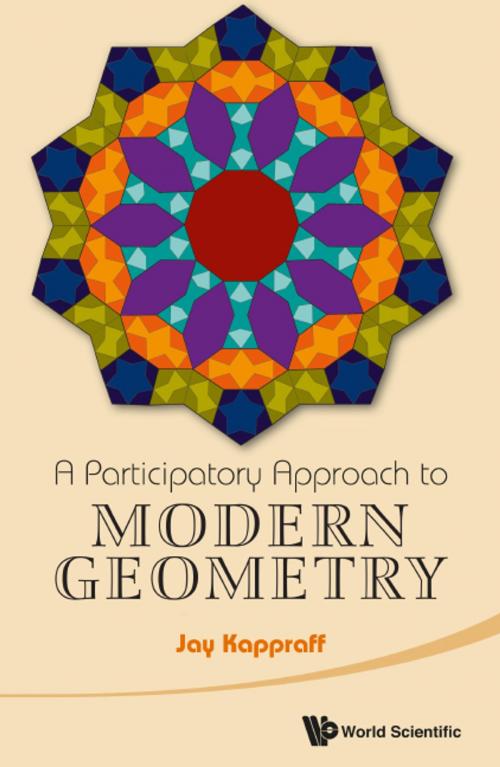A Participatory Approach to Modern Geometry
Nonfiction, Science & Nature, Mathematics, Geometry, Applied| Author: | Jay Kappraff | ISBN: | 9789814556729 |
| Publisher: | World Scientific Publishing Company | Publication: | August 25, 2014 |
| Imprint: | WSPC | Language: | English |
| Author: | Jay Kappraff |
| ISBN: | 9789814556729 |
| Publisher: | World Scientific Publishing Company |
| Publication: | August 25, 2014 |
| Imprint: | WSPC |
| Language: | English |
This book aims to make the subject of geometry and its applications easy and comfortable to understand by students majoring in mathematics or the liberal arts, architecture and design. It can be used to teach students at different levels of computational ability and there is also sufficient novel material to interest students at a higher cognitive level. While the book goes deeply into the applications of geometry, it contains much introductory material which up to now may not have been known to the student. The constructive approach using compass and straightedge engages students, not just on an intellectual level, but also at a tactile level. This may be the only rigorous book offering geometry that attempts to engage students outside of the mathematics discipline.
Contents:
- Triangle and Square Grids
- The Pythagorean Theorem
- Scan Converting of a Line Segment
- Compass and Straightedge Constructions (Part 1: The World Within a Triangle)
- Congruent Triangles
- Introduction to Trigonometry
- The Art of Proof
- Angle
- Voronoi Domains
- Parallel Lines
- Bracing a Framework
- Similarity
- Compass and Straightedge Constructions (Part 2: Doing Algebra with Geometry)
- Area
- Vectors and Geoboards
- Logarithmic Spirals
- The Golden and Silver Means
- Isometries
- Isometries and Mirrors
- Kaleidoscopes and Symmetry
- Groups and Kaleidoscope Symmetry
- Frieze Patterns
- An Introduction to Fractals
- Isometries and Matrices
Readership: Undergraduate students of any discipline interested in improving their visual understanding in geometry.
Key Features:
- Engages the student in hands-on activities using compass, straightedge, and protractor. In talking about areas and vectors, geoboards are used. A giant fractal wallhanging is constructed using the iterative function system. Compass and straightedge is used to create wonderful patterns
- There are many novel topics not covered in other books on geometry such as logarithmic spirals, Voronoi domains with application to pattern recognition, parallel lines with application to bracing a framework, fractals, kaleidocopes, an introduction to group theory
- Projective geometry is introduced at a constructive level. The student is engaged in carrying out 13 fundamental constructions of projective geometry. By focusing on projective geometry, the properties of Euclidean geometry become more understandable — including the nature of infinity and the meaning of parallel lines
This book aims to make the subject of geometry and its applications easy and comfortable to understand by students majoring in mathematics or the liberal arts, architecture and design. It can be used to teach students at different levels of computational ability and there is also sufficient novel material to interest students at a higher cognitive level. While the book goes deeply into the applications of geometry, it contains much introductory material which up to now may not have been known to the student. The constructive approach using compass and straightedge engages students, not just on an intellectual level, but also at a tactile level. This may be the only rigorous book offering geometry that attempts to engage students outside of the mathematics discipline.
Contents:
- Triangle and Square Grids
- The Pythagorean Theorem
- Scan Converting of a Line Segment
- Compass and Straightedge Constructions (Part 1: The World Within a Triangle)
- Congruent Triangles
- Introduction to Trigonometry
- The Art of Proof
- Angle
- Voronoi Domains
- Parallel Lines
- Bracing a Framework
- Similarity
- Compass and Straightedge Constructions (Part 2: Doing Algebra with Geometry)
- Area
- Vectors and Geoboards
- Logarithmic Spirals
- The Golden and Silver Means
- Isometries
- Isometries and Mirrors
- Kaleidoscopes and Symmetry
- Groups and Kaleidoscope Symmetry
- Frieze Patterns
- An Introduction to Fractals
- Isometries and Matrices
Readership: Undergraduate students of any discipline interested in improving their visual understanding in geometry.
Key Features:
- Engages the student in hands-on activities using compass, straightedge, and protractor. In talking about areas and vectors, geoboards are used. A giant fractal wallhanging is constructed using the iterative function system. Compass and straightedge is used to create wonderful patterns
- There are many novel topics not covered in other books on geometry such as logarithmic spirals, Voronoi domains with application to pattern recognition, parallel lines with application to bracing a framework, fractals, kaleidocopes, an introduction to group theory
- Projective geometry is introduced at a constructive level. The student is engaged in carrying out 13 fundamental constructions of projective geometry. By focusing on projective geometry, the properties of Euclidean geometry become more understandable — including the nature of infinity and the meaning of parallel lines















